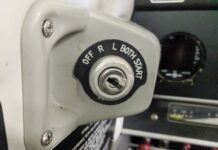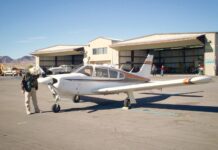Several years ago, a pilot friend of mine went to work for an air cargo operator, in part to gain multi-engine time. His new employer was operating aged piston-engine airplanes in commercial air cargo operations. He and the other crew member were killed in an unfortunate accident. Only recently did I learn the details of his accident, which offers some lessons for all of us.
The twin-engine accident airplane had been experiencing a continuing oil leak from one powerplant’s accessory section. Mechanics worked on the plane while cargo was loaded but hadn’t finished the job by scheduled departure. With my friend’s and the captain’s agreement, a seemingly unimportant part of the inner cowling/firewall was not reinstalled, leaving it for the mechanics at home base do it. The outer cowling was reinstalled, and the airplane took off a few minutes later.
With part of the inner cowling removed, there was no shield preventing the leaking oil from spraying onto the exhaust and catching fire. Within a matter of minutes after takeoff, there was a raging fire that burned into the wing structure. The wing apparently failed from the intense heat and the aircraft crashed only a mile from the airport while they were attempting to return for landing.
‘It’ll Be Fine’

We sometimes lose sight of the fact that in aviation, errors are frequently final and unforgiving. So many times, there is a path that affords the opportunity to say no, but these opportunities are somehow overlooked or bypassed. Routine, indifference or possibly experience with cutting corners and getting by, or even pressure from an employer or coworkers—whether real or perceived—all can be factors here.
No matter what profession you are in, there always are opportunities to cut corners, cheat when no one is looking—who will know the difference? In aviation, you, or someone you care about may be the one on the receiving end of the shortcut. How many times has a pilot busted minimums and made the landing, or a mechanic overlooked a small item that has not been a problem in the past, even though both are technically and legally unacceptable? What about the preflight during which a loose screw was overlooked, or a low tire was bypassed because compressed air wasn’t readily available?
Think of the path a pilot takes to get into flight. Several preflight activities are along that path: checking weather, checking logbooks and maintenance documentation, physically pre-flighting an aircraft, performing a check of onboard equipment and checking the aircraft systems as you taxi for takeoff and finally the pre-takeoff runup and before-takeoff checklist. At any point along this path, you as a pilot can say no and not take the flight.
First Flights
In past articles, I’ve described situations that involved aircraft that were just out of maintenance but had unforeseen deficiencies, even though the aircraft was released for flight. Because humans are involved, these types of mishaps still occur. External factors—weather, schedules and economics among them—all pressure pilots and mechanics to get the job done quickly and on time.
Occasionally, you may find yourself in a situation requiring you to fly an aircraft whose true airworthiness may not be known. It could be a post-maintenance test flight to verify performance and function, or even a ferry flight with a special flight permit to a location where more work will be done. While a licensed mechanic would have been involved inspecting or approving an aircraft for return to service or checked prior to a ferry flight, the pilot has the final say as to whether the aircraft is in a condition for safe operation.
Exercising Your Authority
Never get rushed during a preflight inspection and never take someone’s word for the condition of the aircraft, verifying it yourself. While you as a pilot may not be familiar with all the details of the aircraft components that were worked on, or what was removed to get at the component, it is certainly easy enough to determine if bolts and nuts are secured, and safety wire or cotter pins are in place.
Operational checks of flight controls to determine that they move unrestricted and in the correct direction when operated from the cockpit. Which way should the aileron move when the yoke or stick is moved to the left or right? You should know this cold.
Have any tools or spare parts been left behind? All types of tools, parts and fasteners have been left behind after a project was declared complete: flashlights, bucking bars, pliers, loose rivets, extra nuts and bolts. All of these items and many more can be very hazardous to the operation of an aircraft. What about such items as fuel and oil caps? Are these secure and installed properly? Electrical wiring secured and not hanging or unplugged, and static ports or pitot tubes not blocked?
When flying an aircraft after maintenance, is a test flight required? The pertinent regulation is FAR 91.407, Operation after maintenance, preventive maintenance, rebuilding, or alteration. Even if the maintenance facility involved with the repairs did not specifically state that a test flight is required, one may be necessary, and the pilot is not relieved of this responsibility only because the maintenance technician did not mention it.
Pilots and especially owners should be familiar with this regulation and confer with the maintenance facility or personnel so that this is not overlooked and the aircraft operated illegally. If a test flight is required, it must be documented in the aircraft records and signed as completed by a private pilot or better.

Details Matter
It would also be very wise to be familiar with the aircraft you are about to fly and what the exact requirements for the test flight are. Also important would be an accurate check of the actual weight and balance, as sometimes flight maneuvers are required to be performed and an aircraft out of the center of gravity limits may become uncontrollable when maneuvering. According to FAR 91.407, passengers may not be carried on a required test flight, so plan accordingly when picking up your aircraft.
Other situations that demand full familiarity with a particular aircraft are when an aircraft is just purchased; the new owner should get a complete checkout in it from a CFI before operating the aircraft solo. A complete review of the pilot’s operating handbook, flight manual and additional information on installed equipment is also important. With all the information available for free on the internet, there is no excuse for not being familiar with an aircraft and the operating instructions of optional or additional equipment.
Many general aviation aircraft now have sophisticated equipment installed such as autopilots, GPS and modifications that require advanced knowledge prior to operation, even in good visual conditions, much less IFR. A checkout from a pilot or CFI experienced in the make and model is extremely important. A bad time to experience a problem with an unfamiliar aircraft is on your first solo flight in it.
Numerous problems have been created by an inexperienced pilot getting into trouble with an aircraft he or she is not familiar with. Distractions from unfamiliarity with the operation of installed equipment will remove you from the duties you need to deal with just operating the aircraft safely.
Ferry Flights
Finally, I would like to urge aircraft owners and pilots to take advantage of the FARs and obtain a special flight permit (FAR 21.197) whenever an aircraft does not meet applicable airworthiness requirements but is capable of a safe flight.
Frequently aircraft maintenance facilities are visited by aircraft that do not meet airworthiness requirements for the purpose of maintenance or repair. Even though an aircraft may have had an annual in the previous 12 months, this does not automatically mean it is in airworthy condition at some future date or time.
If there are any doubts as to the condition of an aircraft, contact a licensed mechanic or your local FSDO for further information. Special flight permits typically are not difficult to obtain, so take advantage of this provision of the FARs (21.197). Also check with your insurance agent to see if your aircraft is covered during operation with a special flight permit.
Choose Wisely
Safety, legality and wisdom share a complicated relationship when it comes to aircraft maintenance. The FAA would tell you that an aircraft complying with pertinent rules and regulations is, by definition, safe to fly. But being legal does not make it safe. Ultimately, the pilot’s wisdom (and experience) in assessing an aircraft’s condition will be the deciding factor.




